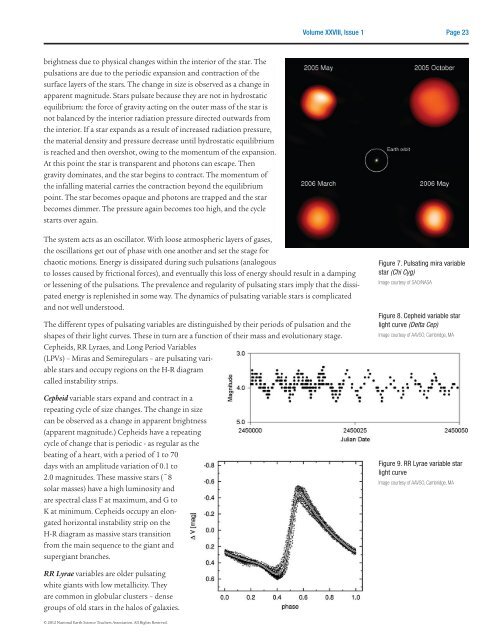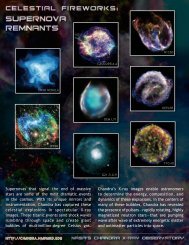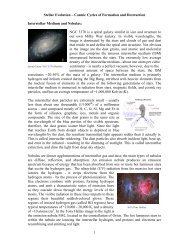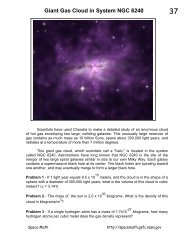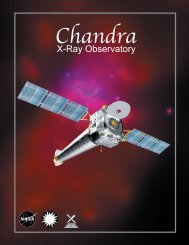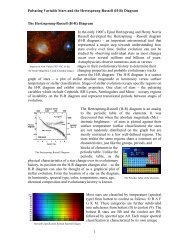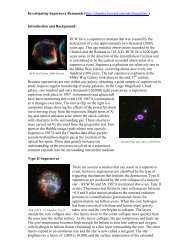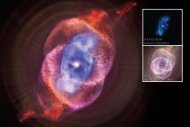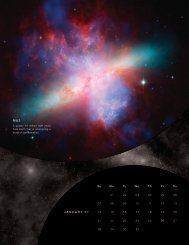Pulsating Variable Stars and The Hertzsprung- Russell Diagram
Pulsating Variable Stars and The Hertzsprung- Russell Diagram
Pulsating Variable Stars and The Hertzsprung- Russell Diagram
You also want an ePaper? Increase the reach of your titles
YUMPU automatically turns print PDFs into web optimized ePapers that Google loves.
ightness due to physical changes within the interior of the star. <strong>The</strong><br />
pulsations are due to the periodic expansion <strong>and</strong> contraction of the<br />
surface layers of the stars. <strong>The</strong> change in size is observed as a change in<br />
apparent magnitude. <strong>Stars</strong> pulsate because they are not in hydrostatic<br />
equilibrium: the force of gravity acting on the outer mass of the star is<br />
not balanced by the interior radiation pressure directed outwards from<br />
the interior. If a star exp<strong>and</strong>s as a result of increased radiation pressure,<br />
the material density <strong>and</strong> pressure decrease until hydrostatic equilibrium<br />
is reached <strong>and</strong> then overshot, owing to the momentum of the expansion.<br />
At this point the star is transparent <strong>and</strong> photons can escape. <strong>The</strong>n<br />
gravity dominates, <strong>and</strong> the star begins to contract. <strong>The</strong> momentum of<br />
the infalling material carries the contraction beyond the equilibrium<br />
point. <strong>The</strong> star becomes opaque <strong>and</strong> photons are trapped <strong>and</strong> the star<br />
becomes dimmer. <strong>The</strong> pressure again becomes too high, <strong>and</strong> the cycle<br />
starts over again.<br />
© 2012 National Earth Science Teachers Association. All Rights Reserved.<br />
Volume XXVIII, Issue 1<br />
<strong>The</strong> system acts as an oscillator. With loose atmospheric layers of gases,<br />
the oscillations get out of phase with one another <strong>and</strong> set the stage for<br />
chaotic motions. Energy is dissipated during such pulsations (analogous<br />
to losses caused by frictional forces), <strong>and</strong> eventually this loss of energy should result in a damping<br />
or lessening of the pulsations. <strong>The</strong> prevalence <strong>and</strong> regularity of pulsating stars imply that the dissipated<br />
energy is replenished in some way. <strong>The</strong> dynamics of pulsating variable stars is complicated<br />
<strong>and</strong> not well understood.<br />
<strong>The</strong> different types of pulsating variables are distinguished by their periods of pulsation <strong>and</strong> the<br />
shapes of their light curves. <strong>The</strong>se in turn are a function of their mass <strong>and</strong> evolutionary stage.<br />
Cepheids, RR Lyraes, <strong>and</strong> Long Period <strong>Variable</strong>s<br />
(LPVs) – Miras <strong>and</strong> Semiregulars – are pulsating variable<br />
stars <strong>and</strong> occupy regions on the H-R diagram<br />
called instability strips.<br />
Cepheid variable stars exp<strong>and</strong> <strong>and</strong> contract in a<br />
repeating cycle of size changes. <strong>The</strong> change in size<br />
can be observed as a change in apparent brightness<br />
(apparent magnitude.) Cepheids have a repeating<br />
cycle of change that is periodic - as regular as the<br />
beating of a heart, with a period of 1 to 70<br />
days with an amplitude variation of 0.1 to<br />
2.0 magnitudes. <strong>The</strong>se massive stars (~8<br />
solar masses) have a high luminosity <strong>and</strong><br />
are spectral class F at maximum, <strong>and</strong> G to<br />
K at minimum. Cepheids occupy an elongated<br />
horizontal instability strip on the<br />
H-R diagram as massive stars transition<br />
from the main sequence to the giant <strong>and</strong><br />
supergiant branches.<br />
RR Lyrae variables are older pulsating<br />
white giants with low metallicity. <strong>The</strong>y<br />
are common in globular clusters – dense<br />
groups of old stars in the halos of galaxies.<br />
Page 23<br />
Figure 7. <strong>Pulsating</strong> mira variable<br />
star (Chi Cyg)<br />
Image courtesy of SAO/NASA<br />
Figure 8. Cepheid variable star<br />
light curve (Delta Cep)<br />
Image courtesy of AAVSO, Cambridge, MA<br />
Figure 9. RR Lyrae variable star<br />
light curve<br />
Image courtesy of AAVSO, Cambridge, MA


